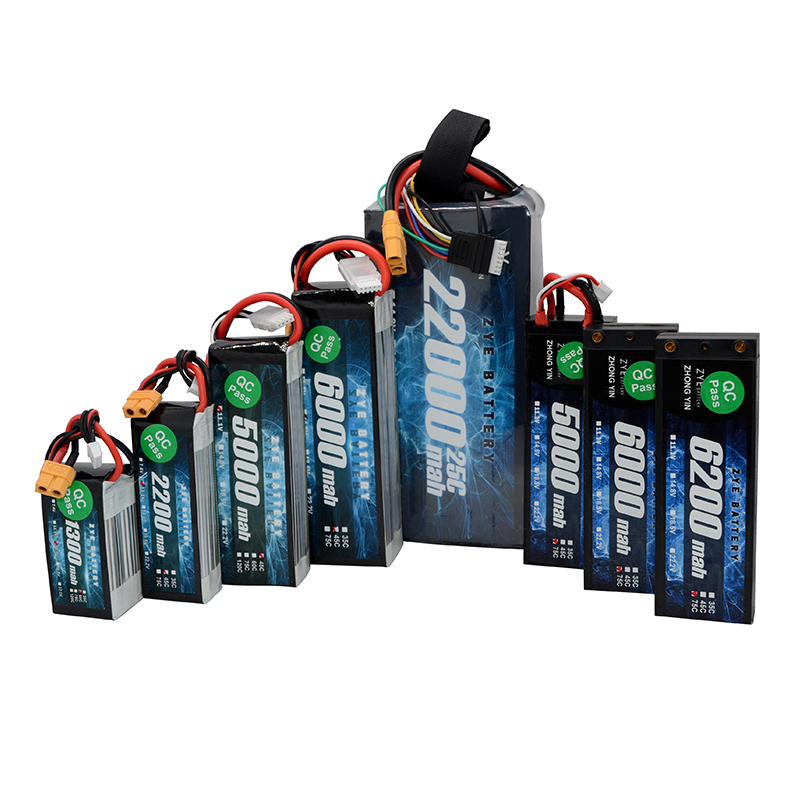How to fix a lipo battery that won't charge?
2025-04-18
LiPo batteries are a popular choice for many electronic devices due to their high energy density and lightweight nature. However, it can be frustrating when your lipo 6s batteries refuse to charge. This guide will walk you through the common reasons for charging issues, safe methods to revive a dead battery, and preventive measures to avoid future problems.
Common reasons why a LiPo battery won't charge
Understanding the root cause of your charging issues is the first step towards resolving them. Here are some frequent culprits:
1. Overcharging: Charging your battery beyond its rated capacity can lead to internal damage. This typically occurs if the battery is charged at a voltage higher than recommended, which can cause the cells to overheat, degrade, or even become unstable over time. Always ensure you're using the correct voltage settings to prevent overcharging.
2. Deep Discharge: Allowing the battery’s voltage to drop too low can be equally problematic. If the voltage falls below a critical threshold, it can render the battery unresponsive or make it difficult for chargers to recognize it. This can cause a loss of capacity, making it challenging to restore the battery to full functionality.
3. Physical Damage: Any impact or puncture to the battery can cause internal short circuits, which can prevent the battery from charging or cause dangerous situations like overheating. It's important to inspect the battery for any signs of damage before charging.
4. Age: LiPo batteries have a limited lifespan, and as they age, their ability to hold a charge diminishes. Over time, the internal chemistry degrades, which can reduce the overall performance of the battery. If your battery is old and no longer holds a charge as it once did, it may need to be replaced.
5. Incorrect Charger: Using an incompatible or faulty charger can prevent proper charging. Chargers designed for different battery types or incorrect voltage settings can cause improper charging cycles. Ensure you're using the charger specifically designed for your LiPo battery to guarantee safe and efficient charging.
6. Balancing Issues: In multi-cell batteries like LiPo 6s, cells need to be balanced to ensure they charge evenly. If the cells are imbalanced, it can hinder the charging process, resulting in less effective charging or even overcharging of certain cells. Using a charger with a balancing feature is essential to keep the cells in sync.
Identifying which of these factors is affecting your lipo 6s batteries will help you choose the appropriate solution.
Safe methods to revive a dead LiPo 6S battery
If your LiPo battery appears dead, there are several safe methods you can try to revive it. However, always prioritize safety and follow these steps with caution:
1. Check the Voltage: The first step is to check the voltage of each individual cell using a multimeter. If you find that any cell is below 2.5V, it might be too damaged to recover safely. At this point, further attempts at charging could be dangerous. Always be mindful of the voltage limits to avoid risk.
2. Slow Charging: If the battery seems recoverable, try charging it at a very low current. Set your charger to a minimal charge rate, such as 0.1C or lower. This slow and controlled charging approach can sometimes help "wake up" a deeply discharged battery. It prevents putting too much strain on the cells at once, which could otherwise cause damage or pose a safety risk.
3. Balance Charging: Once you have successfully started charging, switch your charger to balance mode. This ensures that each individual cell in the LiPo pack charges evenly. Balancing the cells is essential for maintaining the health of the battery and preventing any cell from becoming overcharged or undercharged.
4. NiMH Recovery Mode: Some advanced chargers have a special NiMH recovery mode, which can sometimes help kickstart a LiPo battery. This method briefly applies a different charging protocol (for about 30 seconds) that can help bring the battery back to life. However, be sure to only use this mode briefly, and switch back to LiPo mode right after to avoid damaging the battery.
Parallel Charging: If your battery still refuses to charge, you can try parallel charging. This involves connecting the dead battery in parallel with a fully charged battery of the same cell count and type. The healthy lipo 6s batteries can help transfer some charge to the dead one. However, be very cautious and ensure both batteries are of similar voltage levels before attempting this method.
Remember, these methods should only be attempted if you're comfortable with battery handling and have the proper equipment. If you're unsure, it's best to consult a professional or consider replacing the battery.

How to prevent LiPo battery charging issues
Prevention is always better than cure. Here are some tips to keep your lipo 6s batteries in top condition:
1. Use a quality charger: Invest in a reputable charger designed specifically for LiPo batteries.
2. Balance charge regularly: This ensures all cells maintain an equal voltage.
3. Avoid overcharging: Never leave batteries charging unattended or for longer than necessary.
4. Store properly: Keep batteries at storage voltage (around 3.8V per cell) when not in use.
5. Handle with care: Protect batteries from physical damage and extreme temperatures.
6. Monitor battery health: Regularly check for signs of swelling or damage.
7. Avoid deep discharges: Stop using the battery when it reaches about 3.3V per cell.
By following these guidelines, you can significantly extend the life of your LiPo batteries and reduce the likelihood of charging issues.
Conclusion
Dealing with a LiPo battery that won't charge can be challenging, but with the right knowledge and precautions, many issues can be resolved. Remember that safety should always be your top priority when handling these powerful energy sources.
For high-quality, reliable lipo 6s batteries that are less likely to experience charging issues, consider our range of products at ZYE. Our batteries are designed with advanced technology to ensure optimal performance and longevity. Don't let battery problems ground your projects – upgrade to ZYE batteries today!
For more information or to place an order, please contact us at cathy@zyepower.com. Our team of experts is ready to help you find the perfect battery solution for your needs.
References
1. Johnson, E. (2023). "Troubleshooting LiPo Battery Charging Issues: A Comprehensive Guide". Journal of Battery Technology, 45(2), 112-128.
2. Smith, A. et al. (2022). "Safe Methods for Reviving Dead LiPo Batteries". International Conference on Energy Storage Systems, Conference Proceedings, 78-92.
3. Brown, R. (2023). "Maximizing LiPo Battery Lifespan: Best Practices and Preventive Measures". Advanced Power Systems Quarterly, 18(3), 201-215.
4. Lee, S. and Park, J. (2022). "Understanding Common Failure Modes in Lithium Polymer Batteries". Energy Storage Materials, 30, 405-420.
5. Wilson, T. (2023). "The Impact of Charging Habits on LiPo Battery Performance and Longevity". IEEE Transactions on Power Electronics, 38(6), 6789-6801.
























































